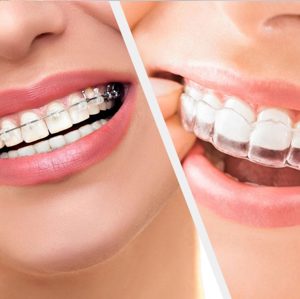Orthodontics
 The area of dentistry known as orthodontics deals with teeth positioned incorrectly. An individual may suffer with eating or speaking if they have an overbite, underbite, overcrowding of teeth, crooked teeth, or a misaligned jaw. In these situations, orthodontic treatment is advised to gradually reposition the teeth so that they are straighter and better aligned. If someone wants a nicer smile, orthodontics can also be employed for cosmetic reasons.
The area of dentistry known as orthodontics deals with teeth positioned incorrectly. An individual may suffer with eating or speaking if they have an overbite, underbite, overcrowding of teeth, crooked teeth, or a misaligned jaw. In these situations, orthodontic treatment is advised to gradually reposition the teeth so that they are straighter and better aligned. If someone wants a nicer smile, orthodontics can also be employed for cosmetic reasons.
A person may have a malocclusion or a poor bite from birth, or they may develop one over time as a result of trauma or unhealthy habits, including thumb-sucking as a toddler. Regardless of the issue, it’s critical to address it quickly. Long-term oral health issues may be brought on by malocclusion, sometimes known as a “poor bite.”
What are the benefits of Orthodontics?
Because misaligned teeth or poor posture increase the risk of dental decay and gingivitis, orthodontics is crucial. An inappropriate bite can make it more difficult or uncomfortable to floss certain teeth, which can lead to poor oral hygiene in those areas and harm your oral health.
Orthodontics is a powerful form of therapy that can be applied to:
- fill in tooth asymmetry
- Make sure your jaw and teeth are in the right position.
- Make teeth more symmetrical.
- Better oral health (such as eating or speech)
- Corrige inappropriate bites
Types of Orthodontics
Metal Braces: Children and teenagers are the target demographic for patients wearing metal braces. They function by affixing the braces to the teeth and tying a wire between them. The elastic ties, which are available in a variety of colours, are used to secure the wire to the braces. At your sessions every 4 to 8 weeks, the orthodontist adjusts the wire to reposition the teeth.
Ceramic Braces: Ceramic braces are transparent, tooth-colored appliances. They function in a similar manner to metal braces but are more covert and less obvious. Patients who don’t think Invisalign or lingual braces are suited for them but still want to straighten their teeth in a discrete and economical fashion are most likely to choose ceramic braces. These patients are mostly young people and grownups who are aesthetic-driven.
Invisalign and Clear Aligners: Patients who had braces when they were younger and merely need a “touch up” or who have mild to moderate dental issues including misaligned teeth, a wide overbite, no problems with their jaw alignment, or who have gaps in their front teeth should consider Invisalign (open bite). But compared to braces, any transparent aligner system, including Invisalign, has substantial drawbacks when it comes to treating complex issues or requiring long-term care.
How do you know if you need an Orthodontic treatment plan?
Dentists can determine whether a patient needs orthodontic treatment by reviewing their dental history, creating a plaster model of their teeth, and/or taking dental X-rays. If your dentist suggests orthodontic treatment, they will refer you to an orthodontist who can create a customized treatment plan for you. We have dentists and orthodontists in our dentist community network who can assist you with any treatment need.
Typically, orthodontic treatment methods involve using a tool that can gently straighten your teeth. Braces, aligners, retainers, headgear, and Invisalign® are a few examples of orthodontic appliances. To get the desired effects, these tools need to be looked after and maintained. To ensure you achieve the best results from your treatment, your orthodontist will provide you with detailed instructions.
